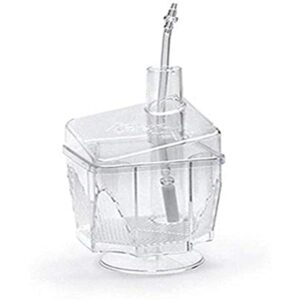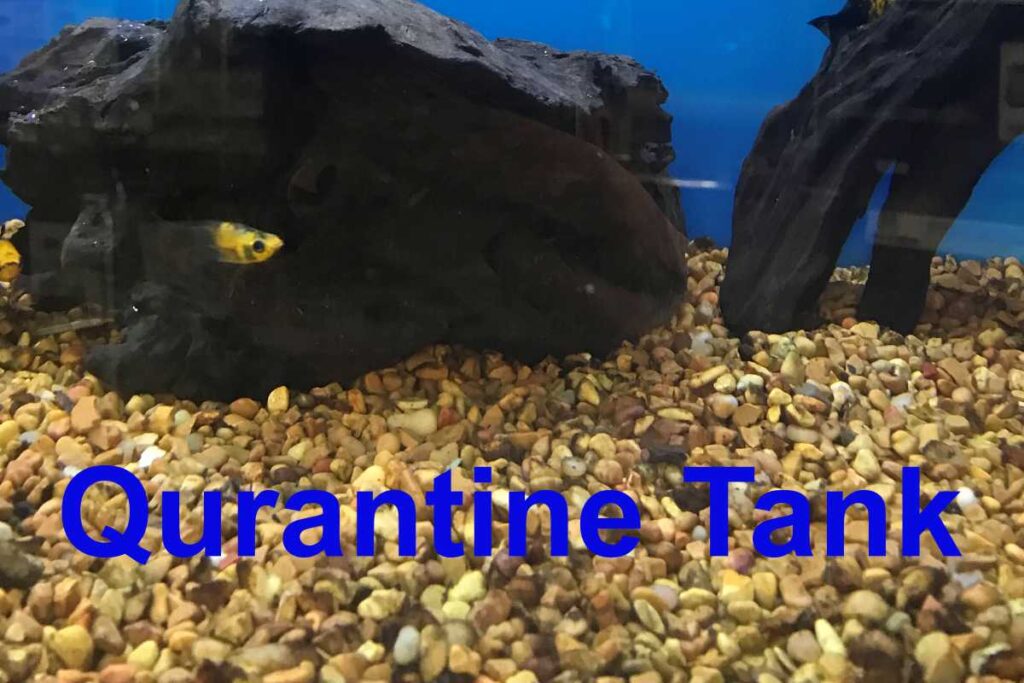There are times when you need to set up a quarantine tank fast for either a sick fish or a new fish that you need to quarantine before putting into your main tank. I have set up lots of quarantine tanks over the years and this is the fastest way I have found get a quarantine tank up and running in less than 30 minutes. In this guide on how to setup a quarantine tank fast I will show you the fastest easiest way to get one set up quickly.
How to setup a quarantine tank fast for sick or new fish
Equipment you will need to set up your quarantine tank.
- Fish tank – 10 to 40 gallons depending on the size of the fish or what you have available
- Air stone
- Sponge filter or corner filter
- Filter media
- Air pump
- Heater
- Plants or decoration for the fish to hide in
Steps to setting up a quarantine fish tank fast
To prevent cross contamination, it is ideal to locate the quarantine tank in a separate room, or at a minimum at least 3 feet away, from the main display tanks. Additionally, it is recommended to use dedicated equipment such as nets and siphons for the quarantine setup and practice good hygiene by washing hands after each interaction with the quarantine tank. This will reduce the risk of transferring any pathogens or parasites from the quarantine tank to the main tank.
step 1: Set up your quarantine tank:
Make sure the tank is clean and all the debris is out of it. If it is a brand new tank I like to take a small amount of bleach and mix it with some water and give the inside a quick rinse to make sure that it is clean and sanitized.
step 2: Fill the tank with a combination of water new and aged aquarium water
Adding water from your current aquarium is the best way to match water parameters that the fish will need to get used to. You should add approximately 50% to 75% old old aquarium water and the rest new fresh water that has had water conditioner added to it.
Step 3: install your filter with an air stone in the fish tank
A corner filter or a sponge filter is the fastest filter to set up and start filtering the water adequately. Both these filters do a great job with biological filtration and some mechanical filtration, since there is not a lot of fish in the tank you do not have to be worried about having an strong filter. I like to use a air stone to run both of these filter as I found that it provides better water movement and oxygenates the surface of the water better.


Step 4: install a Heater in the quarantine tank
Install a small heater that is appropriately sized for the tank you are setting up and is set at the exact same temperature. This is one of the most important steps. If the water temperature is too different than you old tank then the fish may be shocked and it will harm its health even more.
Step 5: add some plants or ornaments for the fish to hide in
When you add fish to a new aquarium they will be a scared and look for a place to hide while they try to figure out their new home. Adding live plants is best from your old aquarium but if you don’t have any it is fine to use fake plants or some rocks or PVC. If you do not have a place for the fish to hide they will become even more stressed out which may damage their health.
You should not add any gravel or substrate to the bottom of the tank because a bare bottom tank is easier to maintain and keep clean. You want to be able to quickly clean up any uneaten food or fish waste before you get an ammonia spike.
Step 6: Add the fish
once your quarantine tank is up to temperature it is time to add your fish. If your fish is new it is best to go through the acclimation process first before adding but if your fish is from your aquarium it can be added right away since the water parameters will be nearly the same.
How to maintain a quarantine tank
Maintaining a quarantine tank involves several key steps to ensure the health and well-being of the fish during their isolation period. These include:
- Keeping water parameters stable: The temperature, pH, and other water parameters in the quarantine tank should be kept at the same levels as the main tank to prevent stress on the fish.
- Regular water changes: Perform regular water changes at least weekly to remove waste and maintain water quality.
- Monitoring fish health: Closely observe the fish for signs of illness, such as abnormal swimming, loss of appetite, or abnormal behavior.
- Isolation: Keep new fish isolated from each other to prevent the spread of disease.
- Quarantine period: Keep fish in quarantine for a minimum of 2-4 weeks before introducing them to the main tank.
- Clean the tank: Keep the quarantine tank clean by removing any debris or uneaten food.
- Treating any illnesses: If any fish show signs of illness, it is important to treat them immediately. This can be done with medication, or by adding aquarium salt to the water.
- Proper filtration: ensure that the quarantine tank has proper filtration to keep the water clean and healthy for the fish.
By following these steps, you can maintain a healthy quarantine tank and minimize the risk of introducing disease or parasites to your main tank.
What is a quarantine tank?
A quarantine tank, is a specialized container or spare tank used to temporarily house new, or ill fish prior to placing them in a primary tank. This is done to prevent the transmission of disease or parasites, to other fish within the primary fish tank. The quarantine tank should be equipped with its own filtration system and be maintained ,at the same temperature and water parameters as the primary tank. Fish should be kept in the quarantine tank for a minimum period of 2-4 weeks before being transferred to the primary tank. Additionally, it is crucial to keep the quarantine tank clean and to perform regular water changes to prevent the growth of harmful bacteria.
Why do you need a quarantine tank?
The use of a quarantine tank is necessary, to protect the health of the fish in a primary tank, by preventing the spread of disease or parasites that new or sick fish may carry. It serves as a buffer zone, where new or ill fish can be closely monitored and treated before being introduced to the main tank, ensuring the overall health and well-being of the fish population. By isolating new or sick fish in a quarantine tank, it also makes it easier to contain any potential disease outbreak and minimize the risk of losing a significant number of fish.
How long should you quarantine fish before adding to tank?
Fish should be kept in a quarantine tank, for a minimum period of 2-4 weeks, or longer before being introduced to the main tank. This time frame is considered sufficient, to allow any potential diseases or parasites to manifest, and for any treatments to take effect. During this period, it is important to closely monitor the fish for any signs of illness and to perform regular water changes to keep the quarantine tank clean. Some experts recommend even longer quarantine periods, up to 8 weeks, depending on the fish species and type of disease being treated.
Do I Need to cycle a quarantine tank?
The process of cycling a quarantine tank is not required, because the water in the quarantine tank is typically aged aquarium water from an established tank. since this water already contains beneficial bacteria, which are responsible for breaking down fish waste and other organic matter. Therefore, when new fish is introduced to the quarantine tank, the waste produced by the fish is efficiently broken down by the beneficial bacteria present in the water, preventing the harmful accumulation of ammonia and nitrite. Additionally, since the quarantine period is relatively short and the number of fish in the tank is usually low, the already present beneficial bacteria are sufficient to handle the bioload, making cycling unnecessary.
How big should a quarantine tank be?
The size of a quarantine tank, should be based on the number and size of the fish, that will be housed in it. A general rule of thumb is to provide at least 2 gallons of water per inch of fish. Therefore, for a small number of small fish, a 10-gallon tank would be sufficient, while a larger number of larger fish would require a larger tank. Additionally, It is important to have a quarantine tank, that allows for proper filtration and adequate water flow to ensure a healthy environment for the fish, during the quarantine period. In summary, the size of a quarantine tank should be determined by considering the number and size of the fish to be housed in it, and ensuring that it provides enough water volume and proper filtration to maintain a healthy environment.











